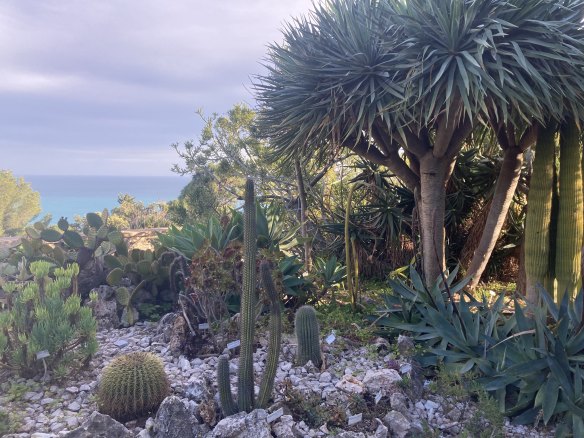[ad_1]
Thomas Hanbury was so determined to only plant what would readily thrive, preserve local flora and lure back birds that anyone would think he was gardening today. However, it was in 1867 that this forward-thinking Englishman acquired a rocky hillside on Italy’s Mediterranean coast and set about leaving no space unused.
Diversity was always Hanbury’s goal. With the help of his botanist brother, he chose plants from similar climate zones worldwide. In went almost 50 different wattles, 40 types of agave, and the finest citrus collection on the Riviera. He expanded, refined, collected and curated until his garden became the destination of choice for both Côte d’Azur holidaymakers and overseas botanists.

The Hanbury Botanical Gardens, in Italy near the border of France, have retained links to the same family for generations.Credit: Megan Backhouse
Even more extraordinary, after Hanbury’s death in 1907, the garden was not lost. Subsequent generations of the family continued to tend this sloping paradise. There were horticultural low points – most notably during the two world wars – but a descendant always returned to cajole the 18-hectare garden back into shape and nudge it into the future.
Today, 157 years after Thomas Hanbury began planting his coastal wonderland, Carolyn Hanbury, representing the fourth generation with ties to the place, lives in a secondary villa in the Hanbury Botanical Gardens.
Although the 18-hectare property, including its 17th-century palazzo, was sold to the Italian state in 1960 and is currently managed by the University of Genoa, Carolyn remains deeply involved with the garden.

The Hanbury Botanical Gardens feature drought-tolerant plants, including many succulents.Credit: Megan Backhouse
It’s interesting what it does for a garden to remain in the orbit of the same family for so long. Despite differences in taste across generations, the garden reflects a steadiness of vision that properties sold more frequently rarely share.
Loading
More plants are left to grow old. They can reach for the sky, carpet the ground and wrap over walls. In some spots, they might even self-seed with abandon. The uninterruptedness of it all becomes central to the atmosphere and, while the gardens are open to the public, they still feel like a thrillingly unpredictable private space.
[ad_2]
Source link